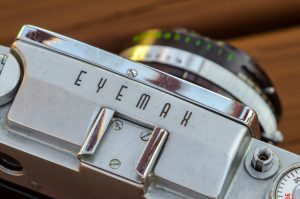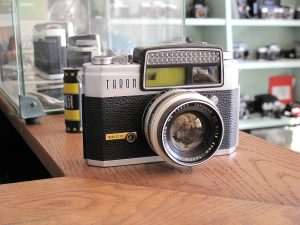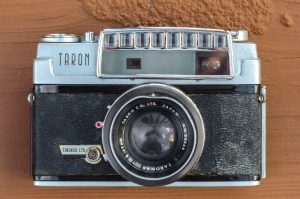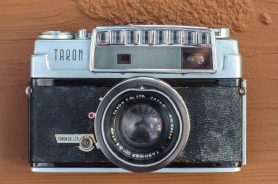 This review is part of the Cameras of the Dead series which I have been publishing every year on Halloween and “Halfway to” Halloween, featuring three cameras that I’ve wanted to review that either didn’t work, or was otherwise unable to shoot.
This review is part of the Cameras of the Dead series which I have been publishing every year on Halloween and “Halfway to” Halloween, featuring three cameras that I’ve wanted to review that either didn’t work, or was otherwise unable to shoot.
I am republishing each of those individual reviews this October in anticipation of this Halloween’s Cameras of the Dead post as a way to revisit the cameras of the past that allows them to be properly indexed on the site.
This is a Taron Eyemax 35mm rangefinder camera made by Nippon Kosokki in 1961. The Eyemax was a mid-level rangefinder that came with either 45mm f/1.8 or f/2.8 lenses. It had a coupled selenium exposure meter located in an elegant chrome frame prominently on top of the camera. The meter was linked to a match needle that was visible in the viewfinder. Match needle systems would become very common in the 1960s, but was still pretty new when this camera was first introduced. The Eyemax was produced for a very short period of time and very little is known about how it was marketed at the time, but it most likely compared favorably to other Japanese made 35mm rangefinders of the era.
 Film: 135 (35mm)
Film: 135 (35mm)
Lens: 45mm f/1.8 Taronar coated 6-elements
Focus: 3 feet to Infinity
Viewfinder: Coupled Coincident Image Rangefinder
Shutter: Citizen MXV Leaf
Speeds: B, 1 – 1/500 seconds
Exposure Meter: Coupled Selenium Cell Meter
Battery: none
Flash Mount: Accessory Cold Shoe and PC MX Sync
Manual: https://www.cameramanuals.org/pdf_files/taron_eyemax.pdf
My Thoughts

The Taron Eyemax is an interesting camera with a chrome grille prominently located above the lens which strongly resembles the massive chrome grills found on American automobiles and large kitchen appliances of the late 1950s and early 60s. It was this bright chrome grille that really drew my attention when I first saw one. Taron rangefinders aren’t exactly rare, as there are always at least a few of them for sale on eBay at any one time, but finding the Eyemax can be quite difficult. The typeface for the Eyemax logo on the top plate of the camera is very stylized and has a 60s “retro” look to it. The “X” in Eyemax kind of looks like an “H”, and I’ve seen at least a few examples of this camera sold as the Taron Eyemah. In his excellent review of the Eyemax, Simon Hawkett says that his example was sold as the Eyemah.
As hard as it might be to find an Eyemax for sale online, finding information about the camera was even harder. I couldn’t find a user’s manual for this camera online. All the usual sources like Mike Butkus’s camera manual site had nothing for this model. Camerapedia has a very short paragraph about the camera, and a Google image search only returns a few random Flickr and eBay photos of this camera.

The company that made the Eyemax was originally founded in Tokyo around 1940 as Nippon Kōsokki Seisakusho. Their most successful products were NKS shutters that were copies of the German Prontor II shutter. Many Japanese cameras from the 40s and 50s had NKS shutters, including my own Zenobia C. NKS survived World War II and would continue making shutters until 1955 when they would release the first Taron rangefinder camera.

The camera was a cleanly designed and well built 35mm rangefinder that probably sold reasonably well. As was common with many Japanese camera makers with Japanese sounding names, NKS would eventually change it’s name to that of it’s most successful product, which was “Taron”. Taron’s Camerapedia article suggests this happened in 1959, but I am not sure if that’s true as I’ve found camera manuals for other 1960s Taron cameras that still credited the company as some variant of Nippon Kosokki. Although Taron seemed to be pretty active releasing a large variety of cameras in the 1960s, they ended up going out of business sometime in the late 60s. Finding any kind of conclusive information about NKS or Taron, their products, and what became of them was quite difficult and as such is why I have very little information about the Eyemax itself.

In what little information I could find, I found evidence of another camera called the Taron Eye, which I believe was released a year prior to the Eyemax. Both the Eye and the Eyemax have a similar selenium meter prominently located on top of the camera, but only the Eyemax has the unique chrome grille. Compare the picture of a Taron Eye to the left with my Eyemax and you’ll see a number of similarities.
The ad to the right appeared in a 1960 issue of Modern Photography and refers to the Taron Eye as the Eyemagic and from what I can tell, has an identical feature set to the Eyemax. The presence of the suffix -max at the end of Eyemax suggests that the Eyemax was an upgraded model, but I cannot tell what was different, other than the added bling of the chrome grille around the meter.
Both the ad to the right and Sylvain Halgand’s page on the Eyemax suggest that both the Eye and Eyemax sold for around $80, which when adjusted for inflation, is comparable to $651 today.
I came across this example in a lot of other cameras that I picked up from Roberts Camera in Indianapolis, including a Bencini Koroll, a Brumberger 35, a Minolta A5, and broken Edixa SLR. I was pretty excited to get the camera and hopefully put it to good use, but upon it’s arrival, the camera was completely dead. The shutter didn’t work, the focus was stuff, the sprockets in the film compartment would not move when winding the camera, the meter didn’t work, and the leatherette was both moldy and flaking off. The Eyemax was one of the most ‘dead’ cameras I’ve ever acquired. Strangely, other than the flaking body covering, and a dent on the filter ring, it was in pretty decent cosmetic shape. The glass looked clean and free of obvious fungus or mold, the rangefinder seemed to work, and the body itself lacked any major dents or gashes. I wonder if someone had attempted to take this camera apart in the past to fix one problem, and ended up causing even more problems before giving up and putting it back together. It seems odd that so many things could simultaneously go wrong in a camera that otherwise is in nice shape.

I wasn’t too disappointed though, as I’ve shot enough 1960s rangefinders that the experience would have likely been similar to other cameras of the era. I could not find any specifics about the make up of the Taronar lens, but it’s probably a 6-element design that produces nice and sharp results comparable to any other period lens with similar specs.
The biggest appeal for me with this camera are it’s looks. I might just clean this up and possibly replace the leatherette with something else because it looks so good sitting on a shelf. While many Japanese companies in the 60s went for simple and clean designs, Taron put a little pizazz in the Eyemax and I think that’s pretty cool. Maybe one day I’ll find another, and if I do, maybe I’ll review it, but for now, enjoy yet another “Camera of the Dead”!
Related Posts You Might Enjoy
External Links
https://camerapedia.fandom.com/wiki/Eyemax
https://simonhawketts.co.uk/2016/01/27/taron-eyemax-35mm-rangefinder-camera/



If you like the look of the Taron Eyemax then you will most likely find the look of the Adox Polomat 1S attrctive, too.
Just saying … and it is “one-ess” and not “fifteen”
I have come across a Taron Eyemax. In the brown leatherette it seems to be in really good condition. However I know nothing about camera that are not digital. I am more than willing to part with this camera for free if you would like it please get a hold of me. I enjoyed your piece on this camera I wish more people took the time to look into the many wonders we have such as this camera. I have a couple of other old cameras as well such as a very heavy Nikon a polaroid 250, a foldex, and last but not least a Kodak that u view from the top.